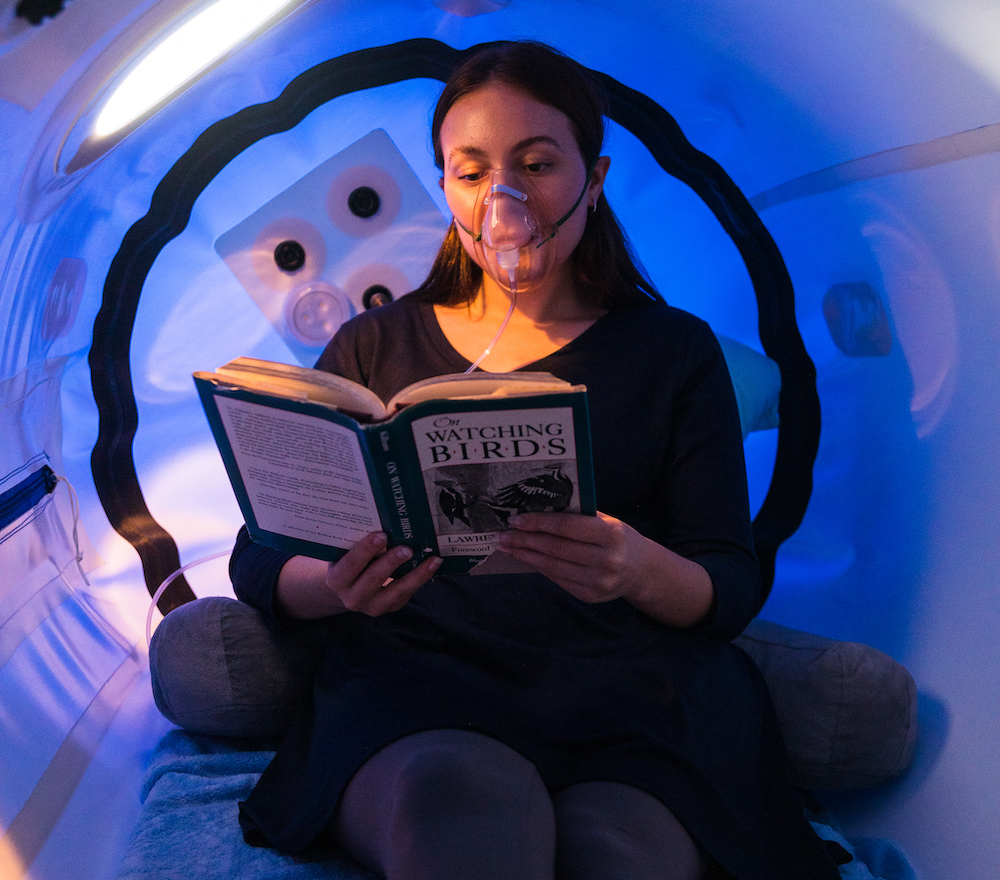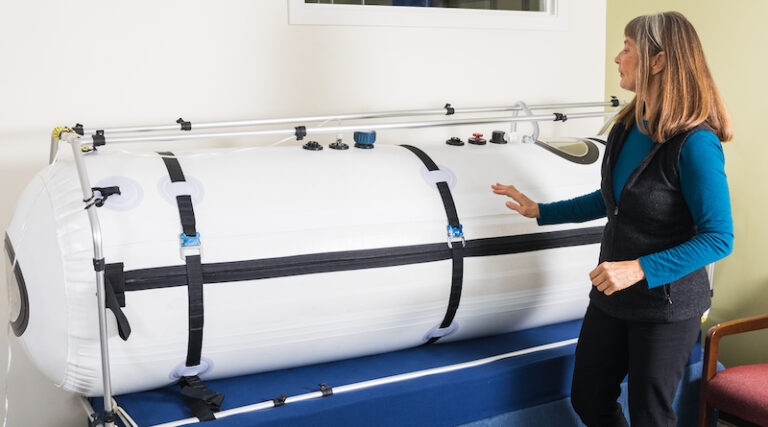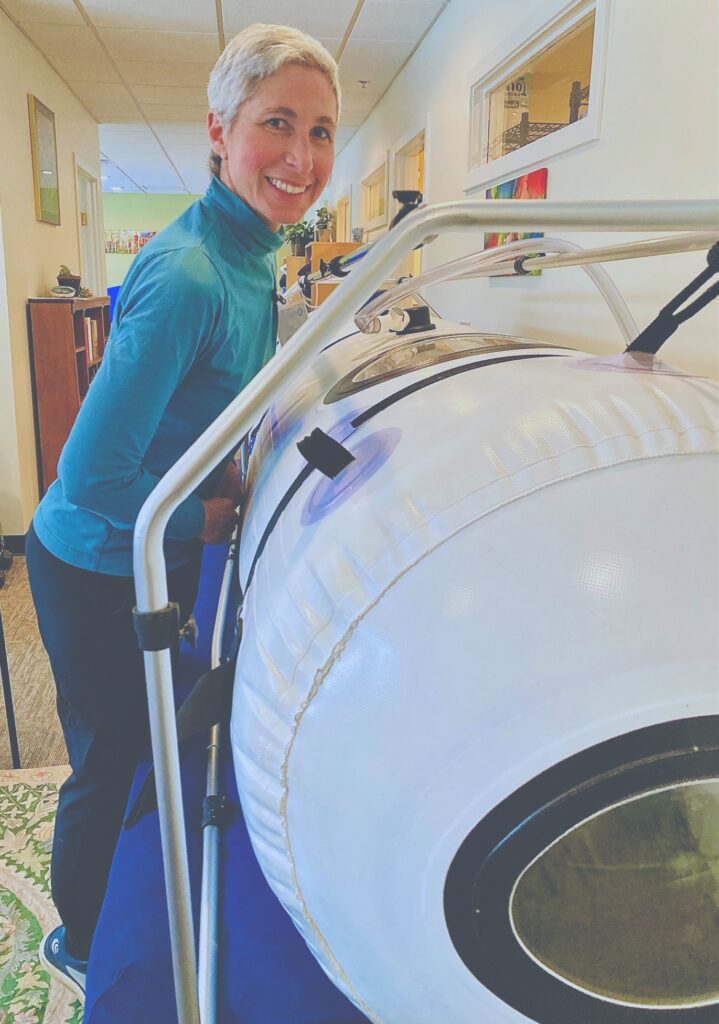
One of the most common questions people ask us about Hyperbaric Oxygen Therapy (HBOT) other than “Will it help me?” is “What’s it like inside the chamber?” Some folks get concerned that the small area inside a chamber might make them feel claustrophobic or that the increased pressure will feel overwhelming.
Other people wonder if there’s a difference between a soft chamber and a hard chamber, or whether high pressure is better than low pressure.
Fortunately, these are fairly straightforward questions to answer. But first, let’s give a little background.
The Pressure
Pressure (what puts the BARIC in hyperbaric) is part of Hyperbaric Oxygen Therapy’s secret sauce. At normal atmospheric pressure (1 ATA), oxygen in the air you breathe is picked up in the lungs by the red blood cells, and carried throughout the body by the circulatory system – the network of arteries and vessels through which blood travels. This is how most medication gets delivered as well.
However, when you increase atmospheric pressure (that’s where HYPER comes from), oxygen is forced into all of the fluids and tissues of the body, including places the circulatory system doesn’t reach.
The Oxygen
Oxygen speeds healing in all kinds of tissues (bone, muscle, organ), and is also:
- Anti-inflammatory
- Anti-viral
- Anti-microbial
These effects are valuable for responding to a wide range of conditions.

Pressure + Oxygen = Healing
Pressure and oxygen together allow for all manner of healing on genetic, physiological, and energetic levels. But not all pressure is created equal.
High Pressure (over 2 ATA) is generally good for acute, immediate, critical issues like decompression sickness, dangerous burns, life-threatening infections, and crush injuries.
High pressure treatments generally take place in a hospital setting using a hard chamber, and with patients breathing 100% oxygen. These treatments, which are for FDA-approved conditions need to be carefully monitored for oxygen toxicity and any potential adverse effects on the nervous system. We should also note that insurance only covers HBOT for FDA-approved conditions.
Low pressure (1.75 ATA) and Mild HBOT (1.5 ATA and below) generally works well for longer term, chronic conditions. At Hyperbaric Vermont, we use soft chambers at 1.3 ATA, with patients breathing approximately 95% oxygen. 1.3 ATA is much less challenging on the nervous system, and at 95% oxygen, there is no danger of building up oxygen toxicity.
Curiously enough, there have been HBOT studies which used less than 1.3 ATA as a control, and discovered that even a little bit of increased pressure has the capacity to be an “active biological intervention.”
Chamber Construction
The material the chamber is made of – basically hard vs. soft – has little relevance. What’s more important is the level of pressure required to treat your particular condition.
Of course, every person is different, and specific needs and conditions will dictate any individual’s course of treatment.

Inside The Chamber
Here at Hyperbaric Vermont, once you get inside the hyperbaric chamber, we turn on motorized compressors to inflate the chamber and an oxygen concentrator to send you oxygen. The concentrator is a simple device which pulls nitrogen out of room air, and sends you enriched (between 92-97%) oxygen.
Both our horizontal and vertical chambers are made of translucent material, and have windows, so there is a great deal of light and a feeling of spaciousness – even when the diameter of the chambers isn’t that large.
Once the chamber is fully inflated, a member of our patient care team will start closing a valve which will slowly bring the pressure in the chamber up to 1.3 ATA. While we can hold you at a lower pressure if needed, the chambers are automatically set to go to a maximum of 1.3 ATA, and cannot go any higher.
You won’t feel the pressure increase physically – there’s no feeling of being squeezed by a boa constrictor or having an elephant standing on your head. However, you might feel pressure change in your ears, much like when you’re taking off or landing in a plane.
Similar to takeoff and landing, there are easy ways to clear your ears, including chewing gum (which we can provide) or holding your nose and blowing gently. Our team can also work with you to manage the rate of pressure change for your greatest degree of comfort.
Once you’re at pressure, you’ll remain in the chamber for an hour or so. While many people watch movies, read, or talk on the phone, we generally encourage patients to close their eyes and relax. It’s a great opportunity to nap knowing that NOBODY is going to bug you while you’re in the chamber!
Our staff will check in on you periodically to make sure you’re comfortable. You’ll also have a 2-way radio to communicate with staff whenever you like.
Ending The Session
At the end of your session, the whole process will be reversed. A member of our patient care team will slowly open the valve and release the pressure in the chamber. Hopefully you’ll have had a nice nap, and will come out feeling refreshed.
If you’re at all nervous about getting into a chamber, our staff is happy to have you come for a visit to show you around the office, let you explore the chambers, and ask any questions before you climb in for treatment.
Feel free to get in touch with us to schedule a visit. We look forward to serving your health and wellness needs!
